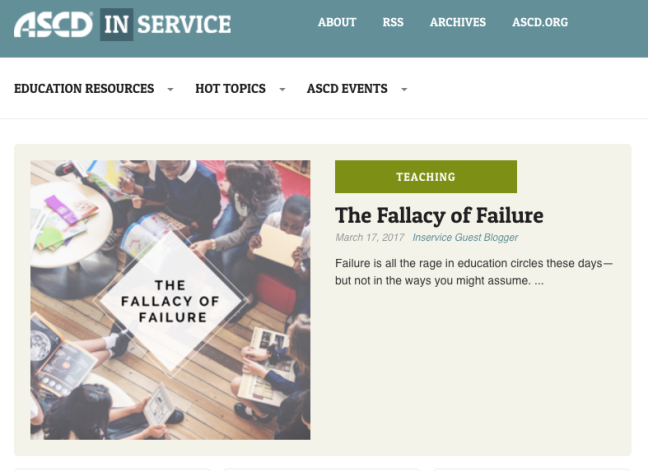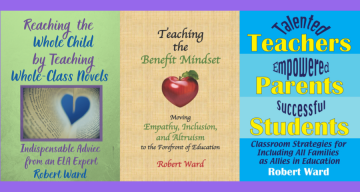Using the word “failure” sends the wrong message to students about what true growth mindset entails. It is time to STOP telling kids to embrace failure and to instead help them persevere through everyday struggles, stumbles, and setbacks while on the way to eventual success.
Failure is all the rage in education circles these days—but not in the ways you might assume. Today’s failure conversation is less about academic grades or the achievement gap and more about how children react to personal letdowns, lapses, and losses.
While this emphasis on the emotional aspect of learning is well intentioned, it misses the mark when it comes to equipping students with true growth mindset. In fact, Carol Dweck found it necessary to dispel common misconceptions and misapplications of growth mindset, a term she coined. As she explained, growth mindset is a thoroughly researched, proven educational tool—but only when employed correctly.

The Failure Fanatics
I also see growth mindset regularly misconstrued, particularly when educators declare how they actively encourage their students to embrace failure. As proud role models of failure themselves, these teachers reveal to their classes that they too fail all the time.
Ostensibly, such empathy and honesty are refreshing. For don’t we want every child to survive adversity with their ego and honor intact? Don’t all students require strategies to assuage their occasional feelings of difficulty, disappointment, and defeat? Isn’t mitigating mistakes a hallmark of growth mindset?
While all of these are correct, we must also realize and teach that outright failure is actually an extremely rare occurrence. Seldom are the instances when a person does not achieve some degree of accomplishment, improvement, or understanding while engaged in a serious endeavor, no matter how short of one’s goals they may have fallen. To say any important effort resulted in abject failure is to focus on the negative rather than on the multiple little triumphs, enlightenments, and headways likely gained in the process.

Figuring Out Failure
Take a moment to reflect upon the personal and professional experiences you have previously regarded as failures. Now, were those blunders, bummers, or blows really as calamitous as the word “failure” connotes? Are you still willing to classify those enterprises as utterly devoid of any redeeming objectives, efforts, insights, or advancements on your part?
Moreover, is this mindset of misfortune how you want your students to approach their education and life in general? Like it or not, this doom and gloom mentality is precisely what the word “failure” suggests.
I find it no coincidence that the term “epic fail” so trendy on social media and in student conversations took root right as teachers began exclaiming, “It’s okay to fail!” the instant a student expressed confusion, experienced challenge, or uttered an incorrect answer.

Forget Failure!
Because I value precision when choosing words, I never use the word “failure” when speaking with my students. I also take issue with the popular F.A.I.L. acronym that sends this ill-considered message: Failure is merely a “First Attempt In Learning.”
Rather, every sincere attempt at learning and personal development consists of positive ventures featuring pluck, perseverance, and patience, all of which are the very factors that most often lead to eventual success. This combination of gumption, grit, and putting one’s nose to the grindstone—along with gathering assistance, advice, and encouragement from experts and allies—transforms aspirations and effort into achievement more often than not. Failure has nothing do with it.
It is not just that failure is not an option; it is that failure is not an outcome to which one should ever give much attention. For to do so is to dwell on a disaster that most likely will never materialize—and certainly not in the completely catastrophic scenario your teachers have heretofore exhorted you to embrace!

Substitutes for “Failure”
We do not fear failure in my classroom, but we do not focus on failure either. Instead, I explicitly state that struggles, setbacks, snags, and stumbles, as well as shifts and switches, are common and necessary parts of growth.
I routinely substitute words like these for “failure” as I underscore to my students that obstacles are to be expected, managed, and placed in their proper context. They are also to be used as the fodder for the wisdom that often can only be gained through direct experience and multiple earnest attempts.
There is no reason to be apprehensive about feeling stuck or stymied. In fact, these hitches and hindrances are natural and ubiquitous. If we want our students to see and share examples of growth mindset, we should focus on anecdotes of exactly how we each strategically overcame, powered through, or enlisted help in order to eventually get the job done—well, on schedule, and with plenty of satisfaction!
Together my students and I honor journeys, no matter how long and winding, and we celebrate progress, even baby steps, on the way to eventual victories. I teach my students to value process just as much as product as we each more forward just a bit each day.
If true growth mindset entails faith backed by finesse, flexibility, and fortitude, then all the more reason to downplay failure and falling flat on your face, both of which are ultimately counterproductive exaggerations that obscure the realities and rewards of rising to challenges. Instead, try featuring for your students all the positive steps and productive strategies that eventually lead to giant leaps forward and the promise of “yet.”
***
I would appreciate your participation in continuing this conversation. In the Comments section below, please add your insights, experiences, and opinions about using the word “failure” with students.

This article was originally featured on the ASCD Inservice blog.

For more on attending to the whole child and how teachers and parents can be allies in education, read the latest book by Robert Ward, Talented Teachers, Empowered Parents, Successful Students.



Failure is when you give up or stop without accomplishing your goal. Education shouldn’t provide an opportunity for students to fail unless they choose it (not willing to give any effort). Students should be given multiple chances to attain their desired outcomes. Tammy Neil has a great blog about this idea https://tammyneil.com/2015/05/22/fail/.
LikeLike
Thanks for your comments and the link to Tammy’s article! I would add that there always needs to be flexibility, especially as children grow and explore. While things like giving up, stopping, and limiting effort are mostly detrimental, they are not necessarily indicative of failure. This is why I added the words “shifts and switches” to this article. Everyone, including children, are allowed to change their goals, alter their interests, or place things on hold.
Of course, much of school is about standards and requirements that must be met, but teachers would do well by infusing those non-negotiables with as much engagement as possible. Here’s how that can be done: https://rewardingeducation.wordpress.com/2017/01/13/the-twelve-cs-of-student-engagement-edutopia-article-by-robert-ward-and-featured-by-the-u-s-department-of-education/ .
The goal should be to move progressively forward while balancing the things that must be done with the things that truly mean something to us. When those two aspects coincide, all the better! Thank you for moving this conversation forward.
LikeLike
https://twitter.com/SchleiderJustin/status/857246604058906624
LikeLike
LikeLike
LikeLike
LikeLike
LikeLike
LikeLike
LikeLike
LikeLike
LikeLike
LikeLike
LikeLike
LikeLike
https://twitter.com/valerietilton/status/842931359836442624
LikeLike
LikeLike
https://twitter.com/OCPSJessSmith/status/843049485127303169
LikeLike
LikeLike
LikeLike
LikeLike
LikeLike
https://twitter.com/kbarikmo/status/843177000449851395
LikeLike
LikeLike
LikeLike
LikeLike
LikeLike
LikeLike
LikeLike
LikeLike
LikeLike
LikeLike
LikeLike
LikeLike
LikeLike
https://twitter.com/SchleiderJustin/status/866446230448218112
LikeLike
LikeLike
LikeLike
LikeLike
LikeLike
LikeLike
LikeLike
LikeLike
LikeLike
LikeLike